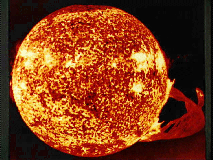Lecture 23 - The Sun (12/8/98)
 Meteorites --- | ---
Origins
Meteorites --- | ---
Origins


Reading:
Chapter 10, 16-1 (ZG4)
The Sun from Skylab, 19 Dec 1973 (NASA).
 |
Key Question: |
How does the Sun shine?
|
|---|
 |
Key Principle: |
Binding Energy
|
|---|
 |
Key Problem: |
How much energy must each kg of
the Sun's core mass generate over the Sun's lifetime?
|
|---|
 |
Key Quote: |
|
|---|
Investigations:
- Structure of the Sun
- What are the densities at the center and surface of the Sun?
- How much of the Sun (in mass and radius) is occupied by the
hydrogen-burning core?
- Where is the radiative zone, where the heat transport is
done by radiation?
- Where is the convective zone, where heat transport is by
gas convection?
- Is there a conduction zone in the Sun, where the heat transport
is by electron conduction?
- How can we "see" into the Sun's core?
- How many neutrinos are liberated for each conversion of 4 H to He?
- What is the neutrino flux at the Earth?
- Why do you need a huge detector to detect solar neutrinos?
- Why do solar neutrino experiments see less than half of the expected
high-energy neutrino flux?
- How do we "see" into the radiative and convective zones of the Sun?
- What is helioseisomology?
- What is the characteristic frequency of solar oscillations?
- How do we map the solar oscillations?
- What has this told us about the interior of the Sun?
- How does the Sun rotate?
- Outer Layers of the Sun
- What happens to the energy at the photosphere?
- How does the temperature, pressure, and density vary as you go
deeper into the photosphere?
- What is limb darkening and what is it due to?
- What sorts of "photospheric weather" are there?
- What causes granulation on the photosphere? How large is a
typical granule and what is the typical convective velocity?
- Why are sunspots dark? How large are they?
- Why do plages exhibit emission lines of hydrogen and calcium?
- What is the chromosphere? When can you see it? How large
and hot is it?
- What is the solar corona? When can you see it? What is its
size, temperature, and density?
- What kinds of "coronal storms" are there?
- How large are solar prominences and what causes them?
- What are solar flares and how much energy is liberated?
- What causes a flare and how does it affect the Earth?
- How long is the solar activity cycle, how is it measured,
and what is it due to?
- Why were there few sunspots or prominences visible on the Sun last
year, but many this year?
- The Luminosity of the Sun
- What are the central pressure and temperature of the Sun?
- How much energy must each kilogram of the Sun's core produce
over its lifetime?
- How many J/kg does TNT produce when it explodes?
- How long could gravitational contraction supply the present
luminosity of the Sun?
- How many J/kg does Uranium or Radium fission produce as natural
radioactivity?
- What is the gravitational force between two protons in a helium
nucleus 2x10^-15 m apart?
- What is the electrical repulsion force between the two protons
in the helium nucleus?
- What is the electrical potential energy between the two protons,
and how is it related to the binding energy in the nuclear force?
- What is the strong nuclear force?
- What is thermonuclear fusion?
- What is the crucial first step in fusing hydrogen into helium?
- If an H-bomb can fuse deuterium (heavy hydrogen)
instantaneously in an explosion, how can the Sun fuse hydrogen safely
for billions of years without exploding?
The Sun on the Web:
Here are some Sun-related resources on the World-Wide Web:
 Prev Lecture ---
Prev Lecture ---
 Next Lecture ---
Next Lecture ---
 Astr11 Index ---
Astr11 Index ---
 Astr11 Home
Astr11 Home
smyers@nrao.edu
Steven T. Myers
 Meteorites --- | ---
Origins
Meteorites --- | ---
Origins

 Meteorites --- | ---
Origins
Meteorites --- | ---
Origins






 Prev Lecture ---
Prev Lecture ---
 Next Lecture ---
Next Lecture ---
 Astr11 Index ---
Astr11 Index ---
 Astr11 Home
Astr11 Home